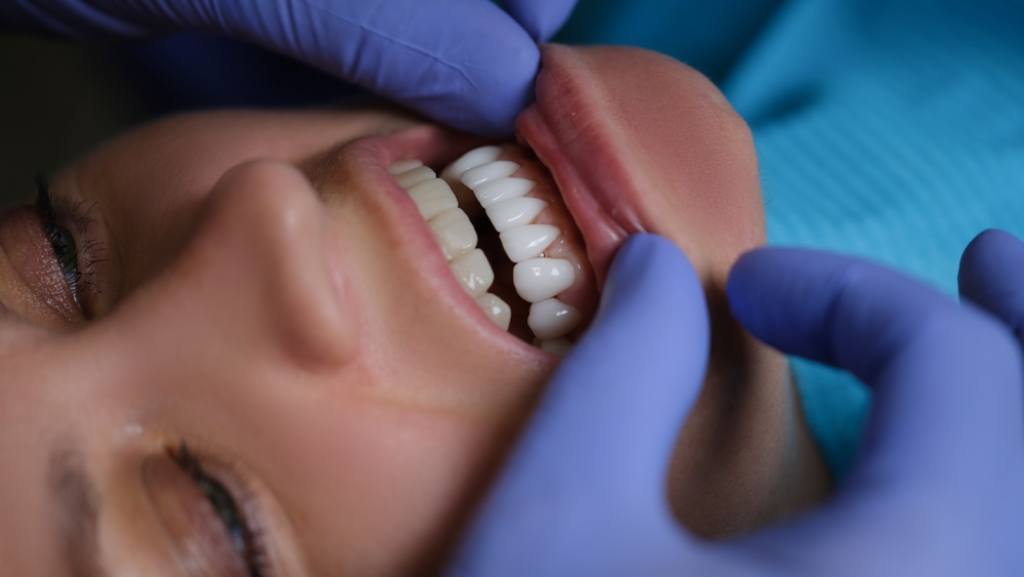Porcelain Veneers vs Lumineers: Which Is the Best Solution?

Deciding between porcelain veneers and lumineers for your smile makeover? Both can transform your smile by covering imperfect or discolored teeth with thin shells. Which is better, lumineers or veneers? Let’s compare these two popular options.
What are Porcelain Veneers?
Porcelain veneers are custom-made shells that are bonded to the front of teeth. The veneers are shaped and colored for the patient’s mouth to create a natural smile.
An experienced cosmetic dentist will first take an impression of the teeth that need covering. Veneers are fabricated in a dental lab to fit over the prepared teeth precisely.
About 1⁄2 a millimeter must be removed from the teeth’s surface to accommodate the shells’ thickness when placing traditional porcelain veneers. This light shaving ensures the final product looks as lifelike as possible without overly bulky teeth. The shell is then permanently cemented onto each prepared tooth.
What are Lumineers?
Lumineers are another great choice in ultra-thin veneers. This leading brand created the original category of no-prep veneers in the 90’s. What sets lumineers apart is that they require no shaving down of healthy tooth structure beforehand. With a thickness of around 0.3 mm, they can simply be bonded on top of your natural teeth.
Lumineers vs Veneers Pros and Cons
Lumineers offer a minimally invasive option for those wanting to keep more of their natural teeth intact. Their wafer-thin design means little enamel needs removing. This helps preserve and protect tooth structure.
Lumineers may work well for mild alignment or staining issues that require more minor corrections. However, the extra thickness could become noticeable on smaller teeth. The custom thinness of regular porcelain veneers creates a beautifully natural, seamless look.
Their durable construction stands up well to years of wear, too. However, traditional veneers do require a minor shaving step to mimic tooth dimensions best. This may be uncomfortable for some patients and risks permanently altering natural teeth.
Here is a breakdown of the pros and cons of veneers vs lumineers and a cost comparison.
Lumineers Pros
- Require little to no removal of healthy tooth enamel
- Less invasive procedure
- Shorter procedure time
- Cost slightly less than veneers
Lumineers Cons
- Not as natural looking as custom-fitted veneers
- More likely to fall off or need replacement sooner
- Less resistant to stains over time
- Not ideal for severely misshapen teeth
Veneers Pros
- Custom-made for your teeth
- Look extremely natural in shape and color
- Resist stains better over many years
- Hold up better over the long term
- Can cover more severely misaligned teeth
Veneers Cons
- Require removal of some healthy tooth enamel
- More invasive procedure
- Longer procedure time
- Cost more per tooth than lumineers
Lumineers vs Veneers Cost Comparison
Regarding investment, the costs of porcelain veneers and lumineers can vary quite a bit. Traditional custom veneers from a cosmetic dentist will set you back anywhere from $250 to $2,500 per tooth.
Several factors affect the final price, including your location and unique needs. Well-known lumineers prices range roughly from $800 to $1,200 per veneer.
Do Lumineers vs Veneers Last Longer?
With good oral care, both veneers and lumineers can provide 10 to 20 years of service to your mouth.. Again, longevity comes down to the skill level of your cosmetic dentist in placing either solution. Porcelain will generally offer better stain resistance over many years than other materials.
Veneers vs Lumineers: FAQs
Do lumineers last as long as veneers?
Both can last 10-20 years with proper care. However, porcelain veneers tend to be more resistant to staining and hold up better in the long run than other materials like lumineers. When comparing lumineers vs veneers pictures, both appear to be in great shape over time
Which requires healthier teeth underneath?
Lumineers leave more of the natural tooth intact and may work well for mild issues. Porcelain veneers can cover more misshapen teeth but do require shaving the teeth first. Patients with severely damaged teeth may need to be better candidates.
Does insurance cover either procedure?
Unfortunately, both lumineers and porcelain veneers are usually considered cosmetic rather than restorative procedures by insurance companies.
That means they are often not covered by dental insurance. As an experienced dental practice, we have established partnerships with various financial institutions, allowing us to offer multiple flexible financing options.
Conclusion
Ultimately, determining whether to go for traditional veneers vs lumineers requires an in-depth conversation with your dentist. After a thorough exam, they can recommend which choice best suits your dental situation.
Those needing only minor adjustments may favor ultra-conservative lumineers. Still, custom-made porcelain veneers create the most seamless and durable smile transformations in most cases when appearance is a top concern.
If you are interested in porcelain veneers or lumineers to help perfect your smile, Cosmetic Dental Implant Solutions can help. Contact us today to set up a consultation.


